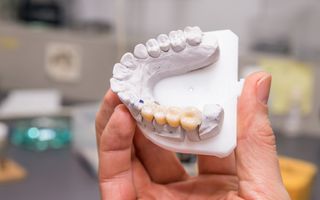
Are you missing one or more teeth? Is it affecting your ability to speak, eat, or smile? At National Dental Care Browns Plains, we understand the importance of a healthy and complete smile. That's why we offer quality dental bridges to restore both the functionality and aesthetics of your teeth.
Our experienced team of dental professionals is here to provide you with personalised, high-quality care. Let us help you regain your smile and improve your oral health with a dental bridge.
What is a dental bridge?
A dental bridge fills a gap between your teeth with false teeth, but without ‘implanting’ them into your jaw like a traditional dental implant. Instead, as the name suggests, a bridge connects a false tooth to your natural teeth on either side of the gap.

Dentist holding a dental bridge before application
They can be a good option if you prefer not to have a dental implant, or if your gums or jaw are not in the right condition to receive an implant.
Types of dental bridges
Bridges are usually made from metal, porcelain, or zirconia (a very hard substance), or a mix of any of the three, and there are three types of dental bridges; Traditional, Cantilever, or the Maryland bridge.
A traditional bridge is the most common and involves placing dental crowns on the teeth on either side of the gap and attaching a ‘pontic’ (a false tooth) between them.
A cantilever bridge is less common. This is when there is only one tooth next to the gap, so the crown is placed over that tooth and the pontic is attached to it. It’s less sturdy than being attached at both sides, so is not a good option for back teeth that need to deal with a lot of pressure.
Finally, there is the Maryland bridge style, named after the University of Maryland where it was invented. It’s similar to a traditional bridge which connects a false tooth to the teeth on each side of the gap, but instead of using crowns for the attachment, it uses ‘wings’ that attach to the back of each tooth next to the gap. Again, this is not ideal for back teeth, and is only really an option for those with good oral health.
No matter the style, a dental bridge at National Dental Care Browns Plains gives you all the functionality of a full set of teeth, as well as a beautiful smile.
How much does a dental bridge cost?
The cost of a dental bridge will vary depending on the type of bridge you get and the materials used, as well as some other factors.
At National Dental Care Browns Plains, your dentist will be able to give you a more accurate estimate once they have a better idea of your situation and oral health.
Keep in mind that your insurance may pay for some of the treatment, so it’s worth checking with your provider.
What to expect from your dental bridge treatment
Before your dental procedure at National Dental Care Browns Plains, it's advisable to eat and drink something. We also recommend that you brush and floss your teeth.

Dentist walking patient through a dental bridge treatment
Here's what you can expect during the first dental bridge appointment at our practice:
- Local Anaesthetic: Your dentist will begin by applying a local anaesthetic to numb the treatment area.
- Tooth preparation: A thin layer of enamel will be removed from the abutment teeth.
- Impressions: Precise impressions or digital scans of your teeth will be taken to be sent to the dental lab.
- Temporary Bridge: The initial appointment will finish with your dentist fitting a temporary bridge to safeguard your teeth until the permanent bridge is ready.
Your next visit, typically scheduled about 2-4 weeks later, will involve the following steps:
- Local Anaesthetic: Your dentist will once again numb the area using a local anaesthetic.
- Temporary Bridge Removal: The temporary bridge will be removed.
- Permanent Bridge Fitting: Your dentist will assess the fit of the permanent bridge.
- Cementing in Place: If the bridge fits well, it will be securely fixed in place using dental cement.
- Custom Shaping: The dental crowns and bridge will be carefully shaped to ensure they match your bite perfectly.
- Numbness: Expect the area to remain numb for several hours following the procedure.
- Follow-up: Your dentist will monitor the bridge's condition during your subsequent appointment.
We're here to keep you comfortable and satisfied throughout your dental bridge procedure. If you have a gap in your teeth and think a dental bridge might be right for you, National Dental Care Browns Plains has the skills and experience to make it happen.
The advantages and disadvantages of dental bridges
Advantages
- Non-Surgical Alternative: Dental bridges are an alternative to invasive dental implants, which involve anchoring the tooth to the bone beneath the gum line. This may not be suitable for everyone, especially those with underlying gum or jaw issues.
- A Complete Smile: Missing teeth can impact your confidence and make you feel self-conscious about your smile. A bridge fills the gap left by missing teeth with a natural-looking solution.
- Restored Functionality: A dental bridge offers full functionality, meaning you’ll be able to eat, drink, and talk normally.
- Improved Oral Health: A missing tooth can cause your other teeth to deteriorate faster, as well as leading to tooth movement. A dental bridge can prevent this, resulting in better dental health.
Disadvantages
- Invasive for Adjacent Teeth: Traditional bridges sometimes require crowns to be placed on healthy adjacent teeth, which may involve reshaping and covering them. This can lead to the removal of some healthy enamel and potentially cause lasting harm to initially healthy teeth.
- Risks of Maryland Bridges: Maryland bridges, while less invasive, can damage existing teeth due to the metal cemented at the back of the teeth. They are also less resilient to chewing pressure compared to other bridge types.
- Ineffectiveness Against Bone Loss: When a tooth is missing or removed, the jaw bone that previously supported it can start to deteriorate. Unlike implants, which have an artificial root anchored into the jaw bone, bridges sit above the gum line and don’t have roots. As a result, bridges don’t prevent bone loss like implants do.
- Shorter Lifespan: Dental bridges may not last as long as implants. A dental bridge will only last as long as the teeth that support it.If there are problems with these teeth in the future, such as decay or gum disease, the bridge will be compromised
It's important to think about these pros and cons when considering whether a dental bridge is the right choice for you. Your dentist at National Dental Care Browns Plains can help you make the best decision based on your individual circumstances.
Ready to restore your smile? At National Dental Care Browns Plains, we offer dental bridges to help you regain your smile and improve its functionality. Book a consultation with us today and take the first step towards improving your smile.
Frequently asked questions
Absolutely! Unlike dentures, dental bridges are permanently fixed to your existing teeth, and cannot be removed without damaging them.
With good care and regular check-ups at National Dental Care Browns Plains, a dental bridge can last for at least 10 years. You will need to avoid biting down on very hard and very sticky foods to minimise the chance of breaking the bridge or even pulling it off.
You will also need to maintain good dental hygiene to keep your natural teeth and gums strong, as these support the bridge.
